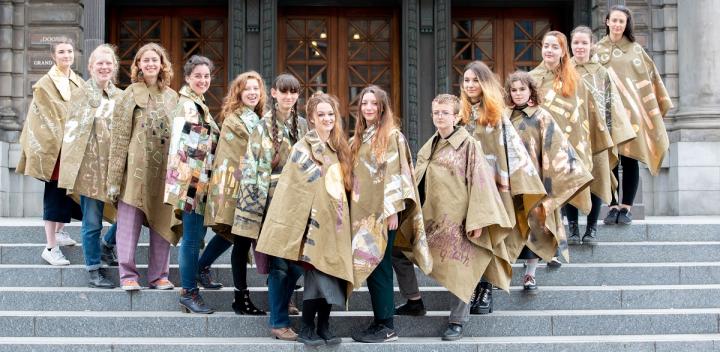Encouraging student talent to shine
Performance costume students partnered with one of the world’s largest arts festivals to spotlight their talent on an international stage.

In 2018, students from Edinburgh College of Art (ECA) created 250 bespoke costumes for the opening show of the renowned Edinburgh International Festival.
More than 15,000 people gathered to watch the outdoor curtain raiser, Five Telegrams, which marked the centenary of the end of the First World War. Huge, colourful projections – designed by award-winning creatives 59 Productions – were beamed onto the city’s Usher Hall facade, accompanied by music from acclaimed composer Anna Meredith.
A creative collaboration
The International Festival has been delighting audiences with its opening displays since 2015. The University has played a key role in these events each year, with students and academics working closely with producers to realise the Festival’s bold vision.
Five Telegrams saw the event directors exploring new territory, adding a live performance element to the multimedia lightshow. A choir, positioned among spectators, sang and shone lights across the audience during one of the show’s five movements.
University students were asked to create outfits for the singers that would make them stand out in the crowd and that reflected the event’s central theme: communication during The Great War.
“We were first told about the project in early January,” recalls performance costume student Rebecca Waites. “It sounded like the most amazing opportunity, although I don’t think that we appreciated how big the event was until nearer the time.”
The brief asked the second and third-year undergraduates to take inspiration from soldiers’ personal communications from the front line during the First World War, specifically looking at information that was censored or redacted.
“We spent three months researching, designing and making,” continues Rebecca.
“As well as developing our ideas, we experimented with fabrics and materials to determine what would work for the event practically.”
Design development
Programme Director Megan Baker – who proposed the idea of the Festival working with her students – led discussions with Event Director Richard Slaney of 59 Productions. “We needed a uniform look to the costumes in order for them to work together,” she says. “They needed to reflect light, have a contemporary feel, and yet resonate with the emotions of soldiers from 100 years ago.”
“When researching the original capes that the soldiers wore, we were struck by how modern they looked,” she continues. “So that became the base shape for the designs using traditional wax cotton, the students then selected a colour palate using reflective foils to radiate light.”
The students’ designs were critiqued at every stage, with direct feedback from the event creators. “It was a really creative process,” says student Callum Miller. “Richard Slaney hadn’t worked with costumes for these events before, so we had to explain things really clearly. It was great to realise that you are an expert in your particular field, and I really felt that when working with Anna and Richard – there was a respect for our skills and opinions.”
Mr Slaney agrees that co-designing the choir’s outfits was a valuable endeavour: “Working with the performance costume students was a fascinating and brilliant experience,” he states. “To put more than 30 individuals’ thoughts and ideas into a unified costume design was a challenge, but represented the stories we wanted to tell.”
He worked with the students to refine their proposals. Once they were signed off, the students began making seven capes each, decorating them in their own distinctive style. Rebecca’s capes were covered in tiny holes, representing the messages redacted from field postcards sent home and the emotional wounds that they left. Meanwhile, Lada Sotirova was inspired by pigeons that sent telegrams during wartime, and Cara MacDonald took her design from the mechanics of machines that sent messages.
Creating student opportunities
The students’ involvement in Five Telegrams was part of the Scottish Government’s Year of Young People 2018, which celebrated people aged eight to twenty-six and showcased their talents. The initiative gave students a range of opportunities to help deliver the International Festival’s flagship event. A number of students were hired to assist at the show and rehearsals, while others were invited to speak at stakeholder meetings during the summer.
Kathryn Weaver, a student who has been involved in more than 20 productions throughout her university career, took the opportunity to make new connections. “It was interesting to get an understanding of the logistics that go into a massive event such as Five Telegrams, and to see established professionals like Anna Meredith present their ideas,” she says. “A number of people asked me about my ambitions and offered advice on routes into the industry – that was invaluable.”
The students’ creativity, positivity and determination never ceases to amaze me.
Five Telegrams provided a visually stunning and poignant start to the International Festival, receiving numerous five star reviews. The scale and ambition of the project reinforced Edinburgh as a major player in the creative arts, and underlined the value of partnership work across the city and beyond.
“The students’ creativity, positivity and determination never ceases to amaze me,” reflects Ms Baker. “It was a privilege to watch their confidence and ambition develop over the course of this project.For the International Festival to dedicate an event like Five Telegrams to our young people, and allow our students to take the reins as they did, was wonderful. It’s clear to me that the future of our creative industries is in very good hands.”
Video
Hear from the students who created the costumes for Five Telegrams.

